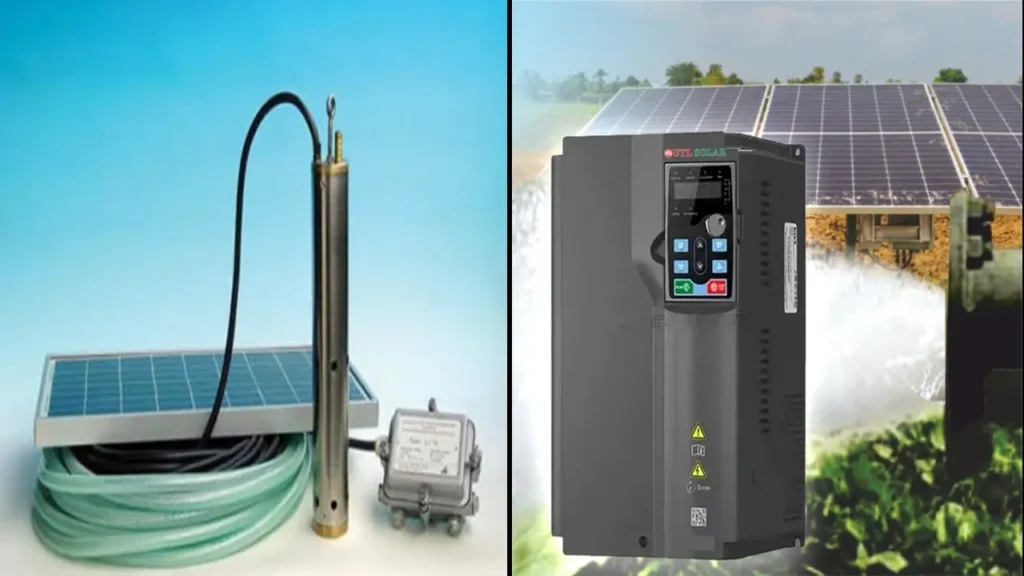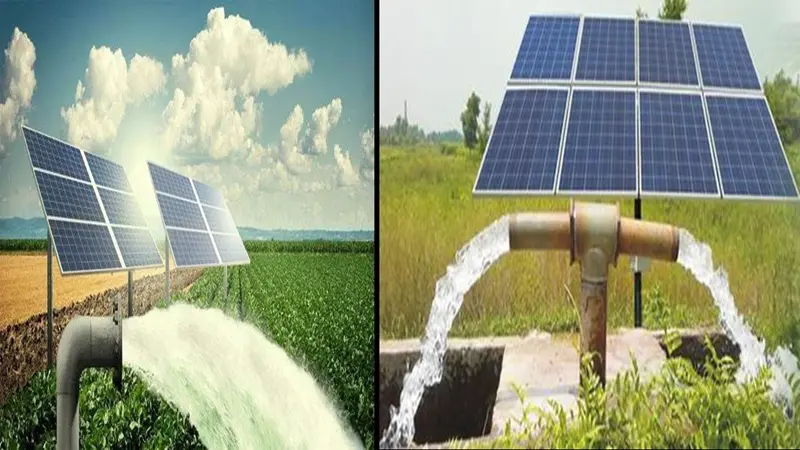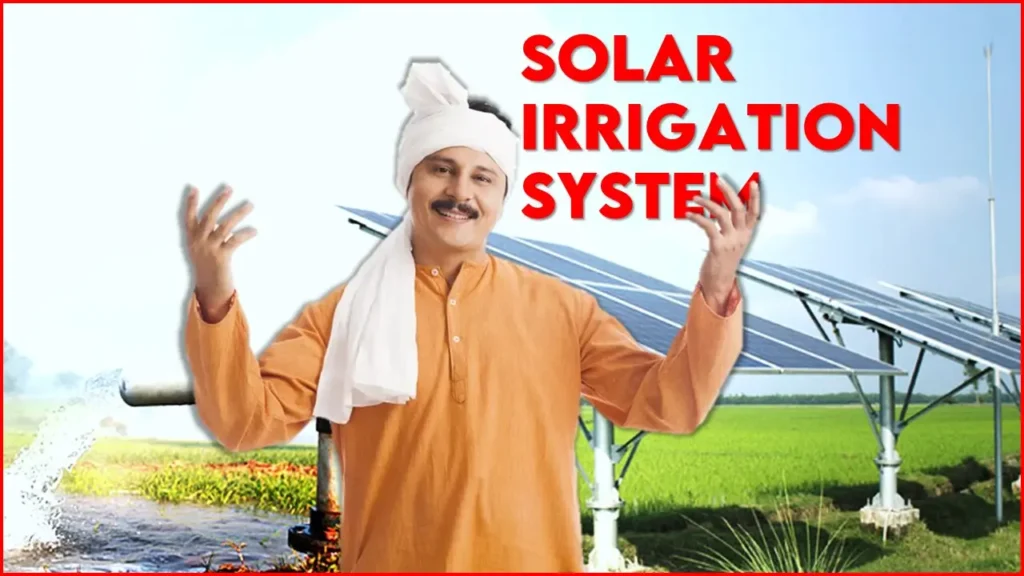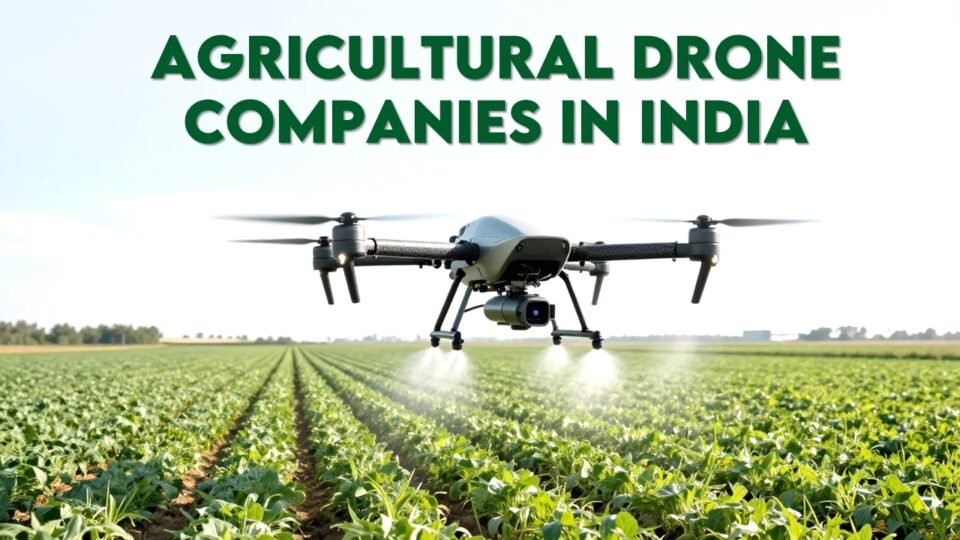Irrigation is the process of supplying water to plants to help their growth typically through channels. The initial systems had to be powered by human/animal labor. Then the water pump was invented, which made the process of irrigation extremely faster and efficient. These were powered by fuel or electricity which carried significant costs.
However, this scenario has also changed slowly with the invention of solar irrigation systems. These systems although require considerable setup costs, they have meager operational costs. So, today we will learn about solar power irrigation systems also known as solar irrigation systems.
What is Solar Irrigation System?
In simple terms, a solar power irrigation system uses the energy from the sun to power a water pump. The pump then moves water from a source, like a well or a lake, to the fields where crops are grown.
The system works best in sunny areas because more sunlight means more energy to power the pump. It’s like how you feel warmer when you’re standing directly in the sun compared to when you’re in the shade. The more sun the solar panels get, the more power they can produce. So, in a nutshell, a solar power irrigation system is like a big, powerful sunflower.
Where Should You Setup a Solar Irrigation System?
Now let’s talk about where to set up solar power irrigation systems. Solar power irrigation systems can be set up in any location where there’s enough sunlight, as the system relies on solar energy to function. This means that areas with a lot of sunny days throughout the year are ideal.
They need to be in a spot that gets plenty of sun throughout the day, year-round, without shade from trees or buildings. The angle of the sun changes with the seasons, so a place that’s sunny in summer might be shaded in winter.
A common approach is to set the solar panels at a tilt equal to your latitude. This means if you’re at a latitude of 30 degrees, you’d put your solar panels at a 30-degree angle. This maximizes their exposure to the sun over the year. If you’re in the Northern Hemisphere, the panels should face true south, and if you’re in the Southern Hemisphere, they should face true north. Solar-powered irrigation systems can also be handy in remote areas with limited or no electricity grid access.
Components of Solar Irrigation System
The key components of a solar irrigation system are
- Solar Panel
- Motor Pump
- Pump Controller
- Storage System
- Irrigation System
Let us understand each of them in detail
Solar Panel
Solar panels are the heart of a solar power irrigation system. The panels are usually arranged in an array to capture as much sunlight as possible.
The solar panels used in these systems are typically rated in terms of their peak wattage (Wp). This is the maximum power output the panel can produce under ideal sunlight conditions. The wattage of solar panels depends on the requirement and the motors used. In India, for example, solar PV arrays having a capacity in the range of 200W to 5kWp are recommended by the government.
The panels need to be placed in a location that gets plenty of sunlight throughout the day and is not shaded by trees or buildings. A common approach is to set the solar panels at a tilt equal to your latitude. This maximizes their exposure to the sun over the course of the year.
The efficiency of the system greatly depends on the quality and placement of the solar panels.
Motor Pump
The motor pump is a key component of a solar power irrigation system. It’s the part that does the heavy lifting, moving water from the source to the fields.
There are two types of motors used in these systems: AC and DC. The choice between AC and DC motors depends on the specific requirements of the system.
DC motors run directly on the electricity generated by the solar panels. Most DC pumps run at 24 volts, but there are also 12-volt systems for light-duty applications and 48-volt systems for heavier applications.
AC motors, on the other hand, require an inverter to convert the DC electricity from the solar panels into AC.
The pump may be surface-mounted or submersible, depending on whether the water source is above or below ground. The impeller of the pump, which is the part that moves the water, must not be non-metallic.
The motor’s power factor, which is a measure of how effectively it converts electrical power into mechanical power, should be at least 0.8. This means that at least 80% of the electrical power is converted into useful work for pumping water.
In India, for example, the majority of the solar pumps are fitted with a 2 – 3.7 kW motor that receives energy from a 4.8 kW PV array. The 3.7 kW systems can deliver about 124,000 liters of water per day from a total of 50 meters setoff head and 70 meters dynamic head.
Pump Controller
The pump controller is a crucial component of a solar power irrigation system.
There are two types of pump controllers: inverters and variable frequency drives (VFDs). The type of controller used depends on the type of motor in the pump.
If an AC motor is used in the pump, an inverter is necessary. The inverter’s job is to convert the DC electricity generated by the solar panels into AC electricity that the pump can use. The supported power range of a typical inverter extends from 0.15kW to 55kW. The higher power inverters are used for larger systems that require more power.
On the other hand, a VFD controller is used to control the speed of the pump. By varying the frequency of the electrical power supplied to the pump, the VFD can make the pump run faster or slower. This allows the system to adjust the water flow rate based on the needs of the crops and the amount of sunlight available.
The controller may also have Maximum Power Point Tracking (MPPT) technology. In terms of specifications, the maximum allowable restarting time for the controller must be less than 120 seconds. This means that if the system is shut down or if there’s a power interruption, the controller should be able to restart the pump in less than two minutes.

Also Read
- Application of Solar Energy in Agriculture in the Modern World
- Modern Tools Used in Agriculture to Protect Crop from Damage
Storage System
The storage system in a solar power irrigation system is an essential component that ensures a continuous supply of power and water.
The battery storage system is like a savings account for energy. It stores the excess power generated by the solar panels during the day. This stored energy can then be used during non-sunlight hours or when the demand for irrigation is high. Deep-cycle batteries are commonly used for this purpose. They are designed to be regularly and deeply discharged using most of their capacity. However, while there are many promising developments in battery technologies, they are currently still costly, maintenance-intensive, and require regular replacement.
The water storage system, on the other hand, stores the water pumped during the day for use when needed. The water is often pumped from a borewell or stream into a storage tank or directly into the field. A more cost-effective option for storing energy is in the form of water pumped to an elevated tank or reservoir during sun hours. The water can then be distributed to the fields using gravity when it’s time to irrigate.
Irrigation System
The irrigation system in a solar power irrigation setup is the final component that delivers water to the crops.
- Surface Irrigation: This is the simplest form of irrigation where water is moved across the surface of agricultural lands. It’s like when you pour water over your garden and let it soak into the ground.
- Localized Irrigation: This is a more precise method where water is applied to each plant or adjacent to it. It’s like giving each plant its own personal watering can.
- Sprinkler Irrigation: In this method, water is piped to one or more central locations within the field and distributed by overhead high-pressure sprinklers or guns. It’s like setting up a sprinkler in your yard on a hot summer day.
The choice of irrigation system depends on the type of crops being grown, the layout of the fields, and the amount of water available. For example, a larger field with a high water requirement might use a sprinkler system, while a smaller garden might use localized irrigation.
Design of Solar Irrigation System
A solar power irrigation system is designed to harness the power of the sun to irrigate crops. The design of a solar power irrigation system is dependent on site-specific biophysical and socio-economic conditions. A qualified system integrator should configure it to ensure proper matching and dimensioning of its components. The most common configuration is a solar generator on a fixed mounting structure providing electricity for a submersible pump installed in a borehole.
Working of Solar Irrigation System
Let us learn how a solar irrigation system works.
Solar Panels
These devices capture sunlight and convert it into electricity.
Motor Pump
This component uses the electricity from the solar panels to pump water from a source like a well or a river. There are two types of motors used in these systems: AC and DC. DC motors are used for smaller applications while AC motors are used for larger systems that require more power.
Pump Controller
There are two types of pump controllers: inverters and variable frequency drives (VFDs). If an AC pump is used, an inverter is needed to convert the DC electricity from the solar panels into AC.
Storage System
This component stores the excess power generated by the solar panels during the day and the water pumped for use when needed. The water is often pumped from a borewell or stream into a storage tank or directly into the field.
Irrigation System
This system delivers the water to the crops. The type of system used depends on the type of crops being grown and the layout of the fields.
So, a solar power irrigation system uses the sun’s energy to water crops.

Advantages of Solar Power Irrigation System
The advantages of the solar power irrigation system are
- Cost-Effective: After the initial setup cost, solar power irrigation systems can lead to significant savings as they eliminate the need for paying electricity bills or buying fuel for traditional water pumps.
- Remote Area Usage: These systems can make irrigation possible in remote areas where access to the electricity grid is limited or non-existent.
- Low Maintenance: Solar power irrigation systems are durable and require minimal maintenance.
- Energy Independence: These systems can increase energy independence by reducing dependence on foreign oil and fossil fuels.
- Scalability and Flexibility: Solar power irrigation systems are scalable and flexible, allowing for adjustments based on irrigation needs.
- Improved Access to Water: Solar power irrigation systems can improve access to water, especially in areas where water resources are scarce.
- Reduced Energy Subsidies: Solar power irrigation systems can contribute to reducing energy subsidies for fossil fuels.
- Increased Productivity: With access to water not being a problem, productivity can increase.
Disadvantages of Solar Power Irrigation System
Here are the disadvantages of a solar power irrigation system
- High Initial Costs: The initial costs for material and installation can be high.
- Space Requirements: Solar power irrigation systems require a lot of space.
- Dependence on Weather: Solar power irrigation systems are dependent on the weather. They work best on sunny days when they can generate a lot of electricity. On cloudy days or at night, the system may not produce much energy, which can affect its ability to pump water.
- Need for a Large Battery Bank: Since solar power irrigation systems do not produce energy at night, there is a need for a large battery bank to store the excess power generated during the day.
- Aesthetics: Some people may find solar panels to be visually unappealing.
- Expensive DC Devices: Devices that run on DC power directly can be more expensive.
- Lower Production in Winter: Solar power irrigation systems may have lower energy production in the winter months due to shorter days and less intense sunlight.
- Unsustainable Groundwater Extraction: If not managed properly, solar power irrigation systems can lead to unsustainable extraction of groundwater.
- Technical Knowledge Required: Effective management and regulation of solar power irrigation systems require some extent of technical knowledge.
Also Read
Conclusion
In solar irrigation systems, the energy from the sun is harnessed and converted to mechanical energy using solar panels and motor pumps. Usually, these pumps for irrigation are powered by using fossil fuels which is costly. This is very important as each rupee saved is beneficial for the farmer. also government provides subsidy for the installation of solar pumps, So even if the installation of solar irrigation is expensive, every farmer should go for it. Because in the long run, it will help to save a huge amount of money.
Latest Post
- Top 10 Agricultural Drone Companies in India
- December Issue 2025- Times of Agriculture Magazine
- November Issue 2025- Times of Agriculture Magazine
- Punjab & Sind Bank Introduces Special Program to Support Food and Agro-Processing Sector
- Beyond Classrooms and Gardens: How a Professor Turned His Passion into Purpose
- October Issue 2025- Times of Agriculture Magazine
- Top 10 Pesticide Companies in the World









